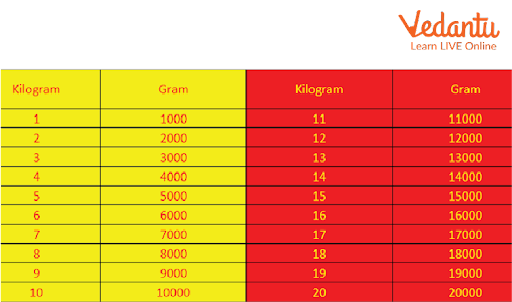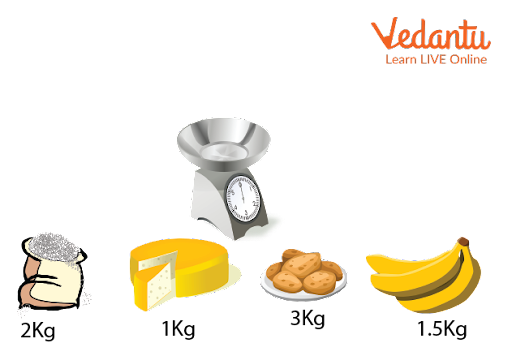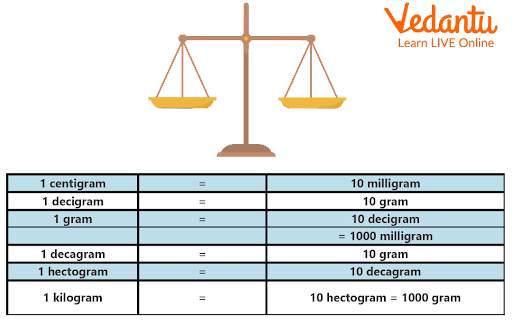




How to Read and Use a Kilogram Chart in Maths
As we all know, a kilogram is a standard unit of mass or weight. The international system of units will consider the kilogram as the SI unit of mass or weight. The word kilogram is a combination of "kilo" and "gram." These are Greek words. The word "kilo" means thousands, and the word "gram" refers to grammar; it means a small unit or weight. The kilogram is represented by the "kg” standard unit of mass or weight.
Kilogram Chart:
The kilogram, denoted by the unit sign kg, is the unit of mass in the International System of Units (SI). It is a unit of measurement that is widely used in research, engineering, and commerce across the globe. Its meaning is "1,000 gram."
Here are some other measurements related to Kilogram.
1 Kg = 2.205 pounds
1 kg = 35.274 ounces
1 kg = 0.001 tonnes
1 kg = 1000 gram
1 kg = 100000 milligram
Gram Milligram Kilogram Chart:
Here we will define the relationship between kilogram gram and milligram through this given chart.
Gram Kilogram Chart:
Here we want to define the relation between kilogram and gram. As we all know, the kilogram is the bigger unit and a gram is the smaller unit of mass. In other words, we can say that the thousandth part of a gram is equal to a kilogram quantity of any object.

Gram Kilogram Chart
Milligram Gram Kilogram Chart:
In this, we will cover the conversion from a milligram to a kilogram of a few weights. This will help to understand the conversion in simple terms.
Gram and Kilogram Chart:
As we know that gram and kilogram are both units of weight or mass. Gram is used for smaller objects measurement and kilogram is determined as the larger or heavier object for measurement. In upcoming examples, we will understand the real-life examples of grams and kilograms.

Kilograms and Grams Examples
In the above example we can see that the banana is 1 kg and 500 grams, the rice is 2 kg, and cheese is 1 kg. These are the examples that we use in our day-to-day life.

Gram and Kilogram Chart
Kilogram Measurement Chart:
As we all know that kilogram is the standard unit of weight. A kilogram is equal to 1000 grams of an object.
1 Kilogram = 1000 grams
We can measure kilogram measurement in different terms. We will use different types of measurement apparatus to measure the actual weight of any object. We can use different types of weight bats like 50 grams, 100 grams, 250 grams, 500 grams, 1 kg, 2 kg, 5 kg, and many more.
Kilogram Conversion Chart:
Conversion Chart;
1 milligram = 0.001 gram
1 centigram = 0.01 gram
1 decigram = 0.1 gram
1 kilogram = 1000 grams
1 gram = 1000 milligrams

Kilogram Weighing Scales
Customary units
1 ton = 2000 pounds
1 pound = 16 ounces
Gram to kilogram chart:
Here we represent a conversion of gram to kilogram chart;
Kilogram Table:
Here is a table which is defined that different type of measurement is related to each other,

Kilogram Table
Conclusion:
In this topic, we will learn about different types of measurement related to mass. The kilogram is the standard and big unit of mass whereas a gram is a smaller unit and a milligram is the smallest unit of mass. In our daily life, we use maximum time as a kilogram or gram. These tables or charts help us to improve our convergence and also it can help to measure mass in different types of units.
Solved Examples:
1. Convert 5000 grams into kilograms.
Solution:
We know that;
1000 gram = 1 kg
5000 gram = 50001000
= 5 kg
2. Converts 21 kg 250 grams in kilograms.
Solution:
1000 gram = 1 kg
250 gram = 250 1000
= 0.250kg
21 kg 250 gram = 21 + 0.250
= 21.250 Kg.
Ans. 21.250 kg
3. Convert 85 kg into grams.
Solution: 1kg = 1000g
85kg = 85 X 1000
= 85000 grams.
Ans. 8.5 decigram
4. Converts 5 kg to pounds.
Solution:
1 kg = 2.205 pounds
5 kg = 5 2.205
= 11.023 pounds
Ans. 11.023 pounds
FAQs on Kilogram Chart Explained with Examples
1. What kg to lbs?
To convert kilograms (kg) to pounds (lbs), multiply the weight in kilograms by the conversion factor 2.20462. The formula is $\text{Pounds} = \text{Kilograms} \times 2.20462$. For example, 10 kg is $10 \times 2.20462 = 22.0462$ lbs. Kilogram conversion charts, like those provided on Vedantu, allow learners to quickly reference common values for accurate and fast calculations.
2. How to calculate kg to grams?
To convert kilograms (kg) to grams (g), multiply the value in kilograms by 1,000, since 1 kg = 1,000 g. The conversion formula is $\text{Grams} = \text{Kilograms} \times 1000$. For instance, 4 kg is $4 \times 1000 = 4000$ g. Vedantu’s kilogram chart helps students understand and memorize common conversions for exam preparation and daily math practice.
3. How much is 100 kg in pounds and stones?
To convert 100 kilograms to pounds and stones:
- Pounds: $100 \times 2.20462 = 220.462$ lbs
- Stones: There are 14 pounds in a stone, so $220.462 \div 14 \approx 15.75$ stones (about 15 stones and 10.5 pounds)
4. What is 75 kg in body weight?
A body weight of 75 kilograms equals 165.3465 pounds (using $75 \times 2.20462 = 165.3465$ lbs). In stones, $165.3465 \div 14 = 11.81$ stones (about 11 stones and 11.4 pounds). Such conversions are essential in fields like health, fitness, and science, and Vedantu’s kilogram chart assists students in mastering these real-world math applications.
5. What is a kilogram chart and how is it useful for students?
A kilogram chart is a visual reference tool displaying common conversions between kilograms, grams, pounds, and sometimes stones. Its benefits include:
- Helping students quickly look up weight conversions
- Assisting with math homework and exam preparation
- Making it easier to understand units of mass in science and everyday life
- Serving as a useful resource for mastering unit conversions, which is a key math skill taught on Vedantu's educational platform
6. What are the steps for converting kilograms to different mass units using a Kilogram Chart?
To convert kilograms to other mass units using a kilogram chart on Vedantu:
- Identify the mass value in kilograms
- Locate the equivalent conversions for grams, pounds, or stones in the chart
- Apply the conversion ratios (e.g., 1 kg = 1000 g, 1 kg = 2.20462 lbs)
- Verify your answer for accuracy
7. How can students memorize unit conversions on a kilogram chart effectively?
Students can effectively memorize kilogram chart conversions by:
- Practicing with sample problems and Vedantu worksheets
- Using mnemonic devices for key factors (like “King George Likes Pies” for Kilograms, Grams, Liters, Pounds)
- Creating flashcards for regular revision
- Studying visual aids such as posters or digital charts provided in Vedantu's math resources
8. What are the practical applications of learning kilogram chart conversions in daily life?
Understanding kilogram chart conversions is helpful in many real-life situations, including:
- Reading food nutrition labels and recipes
- Tracking personal body weight in fitness and healthcare
- Making science lab measurements
- Understanding global weight standards in travel or sports
9. How is the kilogram defined in the metric system and why is it important?
A kilogram (kg) is the base unit of mass in the International System of Units (SI). As of 2019, it is defined by the fixed numerical value of the Planck constant, not by a physical object. The kilogram’s precision and consistency make it fundamental for scientific measurement, education, and all metric mass conversions students learn on Vedantu.
10. What tips does Vedantu offer for mastering kilogram and mass unit conversions for exams?
Vedantu recommends the following tips for excelling at kilogram and mass unit conversions:
- Understand basic conversion factors (1 kg = 1,000 g, 1 kg = 2.20462 lbs)
- Practice using Vedantu’s interactive kilogram charts and quizzes
- Solve sample questions regularly for speed and confidence
- Utilize guided video lessons where teachers explain step-by-step methods























